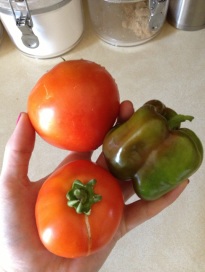As a college student stuck living in town, I’ve had to adjust a lot over the last couple of years. Things such as street lights, pizza delivery, and next-door neighbors are a novelty to someone who grew up in what some would consider as “the middle of nowhere” (actually, it’s really only about 20 minutes to the nearest city). One of the biggest adjustments I’ve had to make is not having a yard. I have to satisfy my itch to dig in the dirt by container gardening. This includes planting flowers in pots, but I’ve also got a small patio garden with 6 pots of bell peppers and tomatoes. As I only have about a 10’x10′ section of concrete patio behind my apartment, I didn’t have room for a lot of plants.
This is an example of urban agriculture. You’ve probably heard of the term before, but for those who haven’t, urban agriculture is basically growing food within city limits (aka not on a rural farm). Urban agriculture includes all kinds of things, such as having a backyard garden, container gardening, indoor gardening, and even community gardens.
Following the recent trends of purchasing produce from farmer’s markets and selecting locally grown foods, urban agriculture has picked up popularity. Container gardening is popular for those who have a small space, such as a patio or balcony (like me!), while a community garden may be a better option for those who are willing to share the harvest (and work) with their neighbors. My 4-H club recently started a community garden to benefit recipients of the local food pantry by offering them fresh vegetables. Our town was very supportive of the idea, allowing us to till a plot in an unused lot and providing us with water. Community gardens are a great solution to those overgrown, unused lots and as a way to provide local food pantries with fresh produce.
Container gardening, on the other hand, is a little more tricky. They produce less than a traditional garden, but are easy to maintain and, best of all, there is no weeding! Plants that successfully grow in containers include some varieties of tomatoes, peppers, lettuce, broccoli, spinach, radishes, and small vine plants such as cucumbers. Just make sure you use a large enough pot (I have each of my tomato and pepper plants in a 12″ pot) for the plant to avoid stunted growth caused by root-bound plants (this is when there is not enough room for the roots to grow and spread out as the plant grows). And be sure to water and fertilize your plants regularly. Potted plants don’t store water as well as soil in the ground, nor do they have access to the nutrients in ground.
Nothing tastes better than homegrown vegetables, and these are a couple of easy ways to save a few dollars at the grocery store. Now please excuse me while I cut up these tomatoes and pepper to make some fresh salsa. 🙂


No Comments